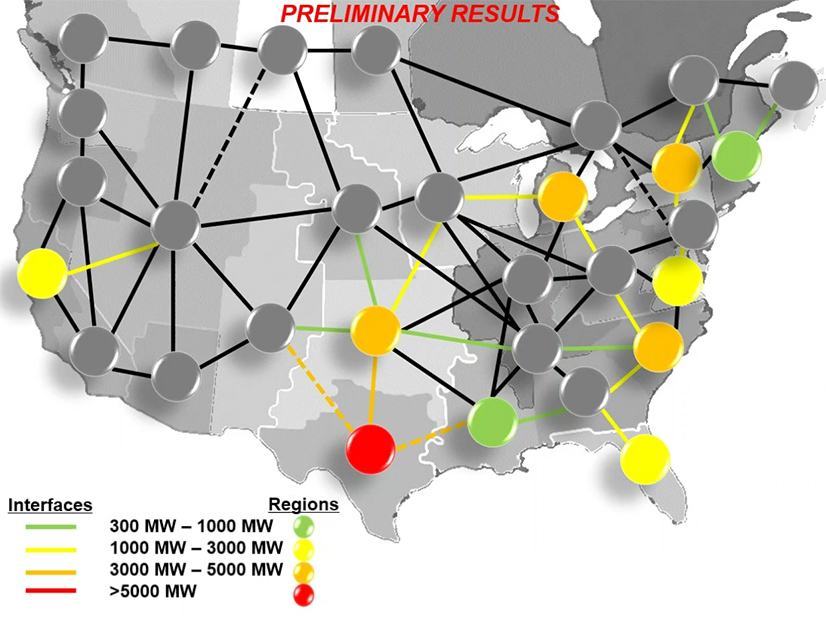
Congress and FERC will need to act to update the rules on interregional transmission planning, and likely permitting, if NERC’s Interregional Transfer Capability Study is going to be of any use, experts said on a webinar hosted by Americans for a Clean Energy Grid.
The study is only the second thing Congress has ever requested from NERC, after it called for the creation of the Electric Reliability Organization in the Energy Policy Act of 2005, said John Moura, director of reliability assessment and system analysis. NERC recently released its initial results, but the final report is not due to FERC until Dec. 2. (See NERC Examines Transfer Capability in Draft ITCS Installment.)
“The ITCS is really an unprecedented study, both in scale and magnitude of what we have to look at,” Moura said. “It’s a U.S.- and Canada-wide technical assessment that looks at the power transfers between regions, and then also makes recommendations to increase those transfers based on reliability needs.”
Once FERC gets the report in December, it will open it up for comments, which will put it before a much larger group of stakeholders, Moura said. Though Congress directed the study, Canadian representatives wanted their own version, which will be published in the first quarter of 2025, he added.
NERC found greater needs for transfer capabilities in some regions compared to others, with Moura presenting a color-coded slide with green, yellow and red for increasing regional needs. While the red and orange areas would benefit from more transfer capacity, Moura noted that the green and gray regions still require work to maintain reliability.
The study assigned “prudent” transfer capability between regions, which means how much is required to meet load under extreme conditions, Moura said.
In doing the study, NERC had to use the same metrics for different regions, which is not how it operates in its own regional planning efforts, so it could accurately assess transfer capabilities. One key finding of the studies is that increasing interregional transfer capability is not enough to ensure reliability.
“I think the results are pretty clear: Adding transfer capability to a minimum level is not sufficient in resolving reliability issues for some areas,” Moura said. “And for other areas, adding transfer capability where it’s not needed would not appear to be economically prudent, without much benefit to reliability. Also, transmission is only one option and only one solution.”
Transfer capability can help with reliability issues in some regions, but so can adding new generation — especially types that are not subject to the same common mode failures plaguing generator availability, Moura said. Higher transfer capabilities will require significant planning and systemwide reinforcements, he added.
Nicole Luckey, Invenergy senior vice president of regulatory affairs, said the current rules are not working.
“There are no holistic interregional transmission planning or cost allocation processes in place today, aside from what was laid out in Order 1000, which I think we all can acknowledge isn’t necessarily working now,” Luckey said. “We’re all really looking forward to the folks in the transmission development community seeing what FERC does with NERC’s study.”
One question is whether the commission will stick to purely reliability benefits or consider others in that effort, she added.
American Electric Power owns utilities in four different ISOs and RTOs, and many of its territories are located along market seams, so it has had a front-row seat to view how Order 1000’s interregional process has failed, said Stacey Burbure, vice president for FERC and RTO strategy. A key reason is that different regions consider transmission with different metrics.
“When you’re comparing apples and oranges, it’s not always intuitive what the right solution is, which is why coordination simply hasn’t gotten us there,” Burbure said. “The RTOs are on different timelines. They’re looking at different inputs. So, moving towards a more standardized approach, with respect to that engineering information, is going to be critical in order to get the right transmission built.”
FERC should take steps with interregional transmission like it did in Order 1920 with regional planning, so the different regions are examining interregional lines on the same basis, she added.
Brattle Group Manager Joe DeLosa agreed that FERC would need to get more common metrics in place to make interregional planning successful, but he also noted that planners currently use models of the system in normal conditions.
The National Renewable Energy Laboratory “has recently said that about half of the benefits of interregional transmission come from the most stressed 5% of system hours,” DeLosa said. “And so, if your interregional coordination/planning, especially for economics, doesn’t take a look at those hours, you’re going to be overlooking large portion of potential interregional benefits, and you’re not ultimately going to develop the appropriate projects.”


